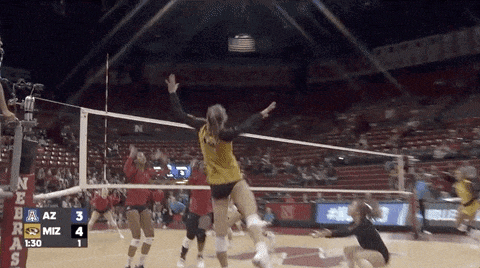Types of Spiking in Volleyball

One of the most exciting and crucial aspects of volleyball is spiking. Spiking, also known as attacking or hitting, is the offensive technique used to score points by forcefully driving the ball into the opponent’s court. In this article, we will explore the different types of spiking in volleyball, how to improve your spiking skills, common mistakes to avoid, strategies and techniques for effective spiking and more.
Definition of Spiking in Volleyball
Spiking is a technique where a player forcefully hits the ball over the net towards the opponent’s court, aiming to score a point by making it difficult for the opposing team to return the ball. It requires a combination of power, precision, timing, and strategy. The spiker, usually an outside hitter or opposite hitter, takes advantage of the setup provided by the setter and attacks the ball from an elevated position near the net.
Importance of Spiking in Volleyball
Spiking plays a vital role in the outcome of a volleyball game. It is an offensive weapon that puts pressure on the opposing team’s defense and creates scoring opportunities. A well-executed spike can demoralize the opponents, energize the team, and sway the momentum of the game in favor of the attacking side. Additionally, spiking is often the final step in completing a successful offensive play and scoring a point, making it an essential skill for any competitive volleyball player.
Types of Spiking Techniques
There are several types of spiking techniques that players can employ based on the situation and desired outcome. Let’s explore some of the most common types:
Power Spike
The power spike is a forceful and aggressive attack that focuses on generating maximum speed and power behind the ball. It involves a strong approach, a high jump, and a powerful downward swing of the arm to hit the ball with force. The objective is to overpower the opposing blockers and drive the ball through or around the block, making it difficult for defenders to dig or return.
Cut Shot
The cut shot, also known as a cross body shot or angle shot, is a technique where the spiker aims to hit the ball diagonally across the court, from one side to the other. This shot involves a slight change in the spiker’s hitting approach and arm swing to create an angle that makes it challenging for defenders to react quickly and reach the ball. The cut shot is particularly effective when the opposing blockers are positioned towards the center of the net, as it exploits the open spaces on the court.
Roll Shot
The roll shot, also referred to as a soft hit or dink, is a finesse technique that involves lightly tapping the ball over the opposing blockers and into the gaps in the defense. This shot requires precise control and touch, as the spiker aims to change the pace and trajectory of the ball, often deceiving the defenders who expect a powerful spike. The roll shot is effective in situations where the blockers are well positioned and a powerful attack might result in a block or a dig.
Tip Shot
The tip shot, similar to the roll shot, is a technique that involves redirecting the ball with fingertips rather than a full swing of the arm. The spiker uses a delicate touch to send the ball over or around the blockers, often targeting the spots on the court where defenders are not positioned. The tip shot is particularly useful when the opposing blockers are anticipating a strong spike, as it can catch them off guard and result in a scoring opportunity.
Slide Spike
The slide spike is a dynamic attacking technique where the spiker approaches the ball from a lateral angle instead of directly behind the setter. This approach involves a quick lateral movement towards the setter’s location, followed by a powerful jump and spike. The slide spike is effective in confusing the opposing blockers and creating a wider angle of attack, making it challenging for the defenders to anticipate and defend against.
Back Row Attack
The back row attack, also known as a back row spike or an attack from the back row, is a technique where the spiker jumps from behind the ten foot line to hit the ball. This type of attack is typically executed by players in the back row positions, such as the libero or the opposite hitter. It requires excellent timing, coordination, and power to generate a forceful spike from a distance. The back row attack adds versatility to a team’s offensive strategy, as it allows multiple players to contribute to the attacking options.
Quick Attack
The quick attack, often referred to as a one tempo or a quick set, is a rapid and explosive spiking technique where the ball is set close to the net and the spiker times their approach and jump to make contact with the ball before the opposing blockers have a chance to react. This attack requires precise coordination between the setter and the spiker and relies on speed and agility rather than sheer power. The quick attack is highly effective in catching the blockers off guard and creating scoring opportunities.
Off Speed Spike
The off speed spike is a variation of the power spike, where the spiker intentionally reduces the speed and power of the attack to create a change of pace. This technique involves a modified arm swing and a controlled contact with the ball, often resulting in a softer and slower hit that surprises the opposing defenders. The off speed spike can be used strategically to exploit gaps in the block or to deceive the defense expecting a powerful spike.
Cross Court Spike
The cross court spike is a spiking technique where the spiker aims to hit the ball diagonally across the court, from one side to the opposite side. This shot requires precise angle control and accuracy, as the objective is to catch the opposing defenders off guard and place the ball in an area that is difficult to defend. By hitting the ball diagonally, the spiker can exploit the gaps in the block and create scoring opportunities on the opposite side of the court.
Line Spike
The line spike is the opposite of the cross court spike, where the spiker aims to hit the ball straight down the sideline of the court. This technique requires precision and power, as the objective is to hit the ball along the boundary line, making it challenging for defenders to make a play. The line spike is particularly effective when the opposing blockers are positioned towards the center of the net, leaving the sideline vulnerable.
How to Improve Spiking Skills
Now that we have explored the different types of spiking techniques, let’s discuss some key methods to improve your spiking skills:
Strength and Conditioning Training
Building strength and power in your lower body, core, and upper body is essential for generating forceful spikes. Incorporate exercises like squats, lunges, plyometrics, and weightlifting into your training routine to enhance your explosive power and overall physical conditioning.
Footwork and Approach Technique
Developing proper footwork and approach technique is crucial for a successful spike. Focus on quick and precise footwork, ensuring you have a strong and balanced base as you approach the ball. Practice your timing and coordination to maximize your jumping ability and generate optimal power during the spike.
Timing and Coordination
Timing is everything in spiking. Work on syncing your approach with the setter’s timing to ensure you make contact with the ball at the highest point of your jump. This coordination will enhance your attacking accuracy and make it more challenging for blockers to anticipate your hits.
Mental Preparation
Spiking requires mental focus and concentration. Visualize successful spikes, develop a positive mindset, and build confidence in your abilities. Practice mindfulness and relaxation techniques to stay calm and composed during intense game situations.
Common Mistakes in Spiking
While working on improving your spiking skills, it’s crucial to be aware of common mistakes that can hinder your performance. Avoid the following pitfalls:
Poor Timing and Approach
Misjudging the timing or having a flawed approach can lead to ineffective spikes. Ensure you have a consistent and well timed approach, allowing you to maximize your jumping ability and generate power at the right moment.
Lack of Power and Accuracy
Spiking requires a balance between power and accuracy. Avoid relying solely on power while sacrificing precision. Aim to hit the ball with sufficient force while also placing it strategically to exploit the defensive gaps.
Predictability
Becoming predictable in your spiking patterns makes it easier for the opposing blockers and defenders to anticipate your hits. Vary your shots, change angles, and mix up your techniques to keep the defense guessing.
Hitting into the Block
Attacking directly into a well formed block is a common mistake. Instead, look for gaps or weaknesses in the block and aim to hit the ball around or through the block to increase your chances of scoring.
Not Adjusting to the Defense
Failing to adapt to the defensive positioning and strategies of the opposing team can limit your spiking effectiveness. Observe the defense, identify their weaknesses, and adjust your shots accordingly to exploit those vulnerabilities.

Strategies for Effective Spiking
To elevate your spiking game, consider implementing the following strategies:
Reading the Setter
Develop a strong connection with your team’s setter and learn to read their setting intentions. Anticipate the type of set they will deliver and adjust your approach and timing accordingly to maximize your hitting opportunities.
Understanding the setter’s tendencies and preferences can give you an advantage in spiking. Pay attention to their body positioning, hand placement, and eye contact to anticipate the direction and height of the set. By reading the setter effectively, you can position yourself optimally for a powerful spike.
Communication with Teammates
Effective communication with your teammates is essential for successful spiking. Coordinate with the setter to ensure they understand your hitting preferences and timing. Communicate with your teammates on the court to create opportunities for quick attacks or to exploit defensive weaknesses. Clear and concise communication can lead to more accurate and powerful spikes.
Exploiting the Opponent’s Weaknesses
Analyzing the opposing team’s defensive weaknesses can give you a strategic advantage. Identify gaps in their block or areas where defenders struggle to cover. Adjust your spiking approach and aim for those vulnerable spots to increase your chances of scoring points. By exploiting the opponent’s weaknesses, you can keep them off balance and gain an edge in the game.
Varying the Attack
Maintaining unpredictability in your spiking approach is key. Mix up your shots, speeds, and angles to keep the defense guessing. Alternate between powerful spikes, finesse shots, and strategic tips to create confusion and make it difficult for blockers and defenders to anticipate your next move. Varying your attack will make you a more versatile and effective spiker.
Conclusion
Mastering the art of spiking in volleyball requires a combination of technique, power, coordination, and strategy. By understanding the different types of spiking techniques, working on improving your skills, and avoiding common mistakes, you can become a formidable spiker on the court. Remember to focus on strength and conditioning, footwork, timing, and mental preparation to elevate your game.
Implementing strategies such as reading the setter, effective communication, exploiting weaknesses, and varying your attack will enhance your effectiveness as a spiker. So, keep practicing, stay confident, and embrace the thrill of delivering powerful spikes that energize your team and help secure victory.


